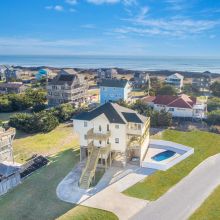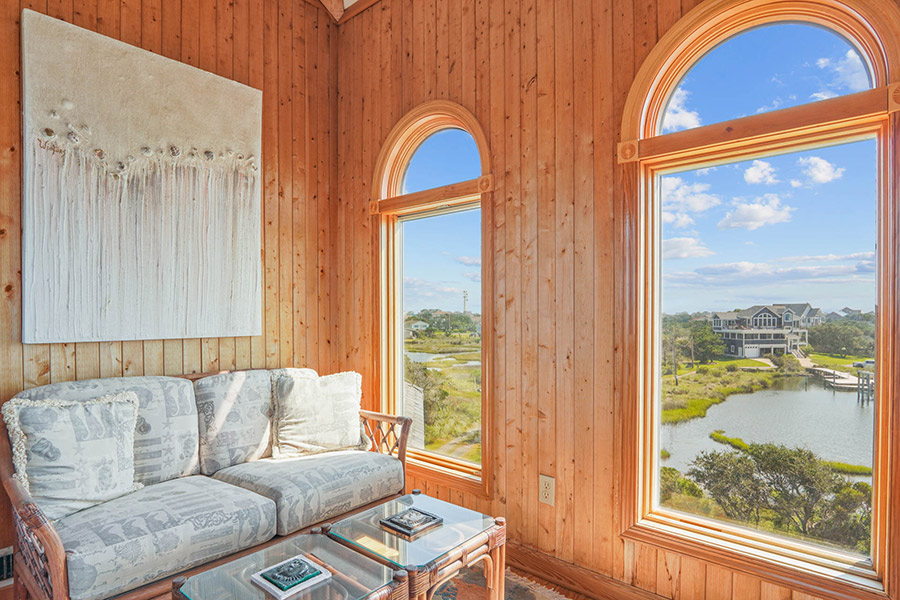Listen To This Article

The Outer Banks took a giant leap onto the nation’s radar during the pandemic, when domestic travel destinations and second homes in outdoorsy locations were in high demand. National publications touted far and wide what we known all along: The Outer Banks is among the top beach vacation destinations in the United States, and it’s also a great place to live. Even as the pandemic has subsided, the Outer Banks continues to gain national recognition.
As always, Dr. Steven Leatherman, aka Dr. Beach, ranked an Outer Banks beach on his list of Top 10 beaches in 2023. For 2023 he named Lighthouse Beach in Buxton as number 5 on the list. In 2022 Ocracoke Lifeguard Beach was number one on the list. Dr. Beach’s 50 criteria range from beach material and water temperature to cleanliness, amenities and local rules in place at the beach.
U.S. News and World Report this summer ranked the Outer Banks as the 10th best summer vacation destination in the country. On its list of the 21 Best Summer Vacations in the USA for 2023, the article cited the abundance of activities for kids and teens, historical sites, lighthouses and clean, wide beaches.

This year Architectural Digest magazine, one of the world’s leading authorities on design, named Kitty Hawk as the best place in the United States to buy a summer beach house. Ocracoke ranked sixth. The article cited home values, weather data, dining, entertainment and air pollution in its considerations.
Travel+Leisure magazine published an article in April 2023 stating that Hatteras Island is one of the best places to buy a beach house in the United States. The article cited unspoiled beaches, rustic charm, wildlife, ocean views and potential rental income as the reasons. The article noted Vacasa data saying that Hatteras homeowners can expect to make up to $60,000 in rental income per year.
World Atlas recently ranked Manteo and Kitty Hawk (and nearby Edenton) as the best N.C. small towns for weekend escapes, and on and on. This is just a sampling of the national press the Outer Banks received in 2023, and it has led to continued interest in Outer Banks home buying.

During the pandemic years of 2021 and 2022, all of this helped contribute to a frenzy of Outer Banks home buying. According to data from the Outer Banks Association of Realtors, total sales in 2021 were 2,766. But the market is correcting, as in 2022 that level dropped to 2,118, and in 2023 (as of July) the level of total sales was down to 1,415. In July 2023 the Outer Banks was mirroring the national trend of decreasing home sales due to low inventory and high interest rates.
Data from Outer Banks Association of Realtors through July 2023 showed that overall inventory in Dare County, Currituck County and Ocracoke was down 22 percent. At the end of July 2023, for example, there were 456 residential units, 352 lots and 31 commercial units for sale. For comparison’s sake, in July 2022, there were 561 residential units on the market, and in July 2021 there were 477.
Alongside the drop in inventory, real estate prices are rising. The median residential home price in July 2023 was $599,499, up 2 percent from July 2022 and 14 percent from 2021 (when the median home price was $490,000). In 2023 homes were staying on the market longer, for an average of 53 days as compared to 35 days in 2022.
In terms of new construction, Hatteras Island and unincorporated areas of Roanoke lead the other areas of Dare County in new residential construction permits. Currituck County has seen a surge in new construction permits as well, the majority in Moyock near the Virginia border, but the second and third most in Corolla and Carova. Corolla is seeing a good amount of property turnover with an eye toward remodeling older beach houses.

Alongside the trends in the real estate market are the hot topics of conversation on the Outer Banks real estate front.
One topic every Outer Banks property owner and potential property owner should be paying attention to is homeowners insurance.
Home insurance is a big consideration on the Outer Banks, where hurricanes, tropical storms and nor’easters have the potential to cause major property damage. Wind and hail insurance and flood insurance are required on mortgaged properties, of course, but Outer Banks Association of Realtors Director Willo Kelly notes that a good number of homebuyers on the Outer Banks are cash buyers, as in they have no mortgage. Since they are not required to purchase insurance, some of these buyers may choose to forgo it, especially flood insurance.
“Being underinsured or not insured is a big concern, especially if we have a big hurricane,” Kelly says. “In such a case, we may see properties that sit for a long time in a state of disrepair.”
On a positive note, Kelly notes that the low property tax rates on the Outer Banks offset the costs of homeowners insurance here. At least for now – as long as insurance rates stay stable.
Outer Banks property owners and potential property owners who plan to rent their property, either long-term or short-term, should be paying attention to a proposed insurance rate hike for rented properties.
The N.C. Rate Bureau, which represents insurers across the state, has proposed raising insurance rates on rental properties, which could lead to an increase of more than 75 percent on new and renewing wind and hail policies for vacation and full-time rental houses on the Outer Banks. N.C. Insurance Commissioner Mike Causey has said his department does not agree with the hike and has set a hearing for April 8, 2024, in Raleigh. According to the request, fire policies are proposed to go up by an average of 17 percent statewide, and wind and hail policies, which are required for mortgage holders on the Outer Banks, would go up by an average of 59.8 percent.

In good news for buyers, as of March 2023 North Carolina now requires flood disclosure, thanks to the North Carolina Real Estate Commission. The commission now requires a property’s flooding history to be included in a property’s disclosure requirements. This means that home buyers have the right to know a home’s flood history before they buy.
Another huge topic on the Outer Banks is affordable housing for the workforce – or, more to the point, the lack thereof. The workforce is being edged out of the local housing picture due to rising home prices and low inventory as well as to the abundance of short-term vacation rentals. It is a highly complicated topic of much discussion among local counties and towns, with the need for balancing the complications related to population density (septic and environmental health, stormwater and traffic concerns among them) with the dire need for affordable workforce housing.
What it all boils down to is that the Outer Banks is a highly desirable place to live and visit and an optimal place to own a second home — and that is no longer a secret.


 Molly Harrison is managing editor at OneBoat, publisher of OuterBanksThisWeek.com. She moved to Nags Head in 1994 and since then has made her living writing articles and creating publications about the people, places and culture of the Outer Banks.
Molly Harrison is managing editor at OneBoat, publisher of OuterBanksThisWeek.com. She moved to Nags Head in 1994 and since then has made her living writing articles and creating publications about the people, places and culture of the Outer Banks.




